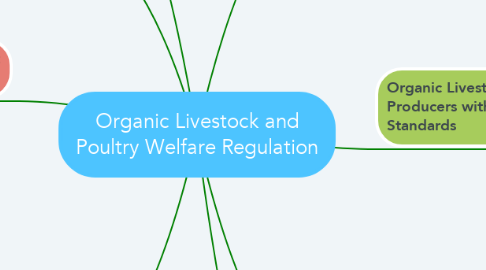
1. Organic Livestock and Poultry Producers with High Welfare Standards
1.1. Don't want to be seen as equal cost comparison to farms without animal welfare practices
1.1.1. unfair comparison
1.1.2. at same consumer price, low welfare producers would profit more
1.2. requires financial sacrifices to maintain higher ethical standards
1.2.1. sacrifices can help ensure consumer brand loyalty
1.2.1.1. less prone to scandal
1.2.1.2. requires additional marketing to communicate differentiations
1.2.2. sacrifices may pay off via fewer infections or herd losses, better flavor
2. Organic Livestock and Poultry Producers Satisfied with Original NOP
2.1. Advantages for large-scale producers where decision makers are detached from witnessing or facilitating animal suffering
2.1.1. numbers are priority
2.1.1.1. for corporations, all actions must be conducted for the financial benefit of the shareholders
2.1.1.1.1. difficult to justify financial sacrifices for animal welfare
2.1.1.1.2. Many "owners" aren't even fully cognizant of company practices
2.1.2. managers and employees are easier to replace than in a small-scale operation
2.1.2.1. less power for concerned workers to strike or demand alterations
2.1.2.2. large legal departments can keep animal abuse incidents from being revealed via NDAs
2.1.2.3. less incentives to treat workers well
2.1.2.3.1. frustrations of workforce may translate to blatant abuse of animals
2.1.2.3.2. inexperienced workers more likely to make mistakes
2.2. Areas with heavy snow or severely-low temperatures cannot provide outdoor access during full winter season
2.2.1. Disproportionate challenge to northern states
3. Consumers Concerned with Animal Welfare
3.1. Willing to pay more for higher animal welfare practices
3.2. Want to be able to distinguish between organic products with higher animal welfare practices
3.2.1. Maybe an additional 3rd party 'animal welfare' certification could denote these products
3.2.1.1. Could be governed by the USDA or by a separate organization
3.2.1.2. would non organic producers qualify?
3.2.2. May conduct independent research into a farm's specific animal welfare practices
3.3. Don't want to sponsor animal abuse
3.3.1. may shift to veganism if labeling is uncertain
3.3.1.1. reduces national consumption of animal products
3.3.1.1.1. positive environmental consequences- less methane and more efficient food sourcing
3.3.1.1.2. harmful to animal products industries
3.3.2. may shift to local animal products if labeling is uncertain
3.3.2.1. may self-produce eggs
3.3.2.2. purchase meat from known farmers
4. Consumers Concerned Mainly with Physical Product Healthiness
4.1. Satisfied with absence of herbicides, synthetics, hormones, and reduced antibiotics
4.1.1. current compliance with NOP
4.2. prefer to stay detached from the actual production practices of animal products
4.2.1. intimately knowing the animal behind the product may ruin the flavor experience
5. Grocery Retailers
5.1. Want low-cost, high-margin products
5.1.1. ensure customer excitement for "good deals"
5.1.2. Generate higher profits
5.2. limited shelf space
5.2.1. difficult to present an extensive range of animal welfare compliance
5.2.2. desire simplified, but competitive supply chains
5.2.3. Most grocery stores already have a limited "Organic foods" section
6. Organic Food Processors that Utilize Animal Ingredients
6.1. ingredient sourcing
6.1.1. higher profits if ingredients are less expensive
6.1.2. source often unknown to the customer
6.2. marketing
6.2.1. "organic" label is typically sufficient for indication of production integrity
7. Organically-raised Livestock and Poultry
7.1. Enjoyment of life centers on reduction of traumatic experiences
7.1.1. animal behavior experts need to determine a species' innate experiences
7.1.1.1. confinement
7.1.1.2. large groups
7.1.1.3. loud noise levels
7.1.1.4. ease of access to food and water
7.1.1.5. slaughter experience
7.1.1.6. separation from family
7.1.1.7. air purity and methane levels
7.1.1.8. presence of feces and waste
7.1.1.9. facility temperatures
7.1.1.10. culling
7.1.1.11. treatment by workers
7.1.2. kosher 2.0
7.2. are not people
7.2.1. communication barrier
7.2.2. different preferences
